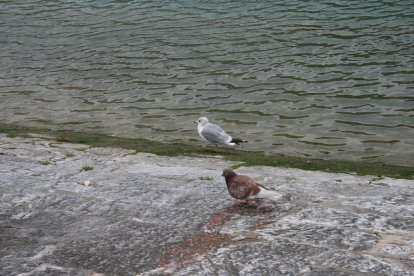
Photo: A dove and a common gull (Larus canus) on the shore of the Rječina
River (Photo by A. Radalj)
COMMON GULL SIGHTED ON THE RJEČINA RIVER
While searching for the swans ringed a few days earlier
on the Rječina River, Andrej Radalj, external associate of the Institute
of Ornithology and the Public Institution “Priroda”, sighted
and photographed a common gull (Larus canus) alongside the bed of the
Rječina River in the Školjić area. Although similar to the Yellow-legged
Gull, the Common Gull is smaller, with its distinguishing feature being
the uniform, yellowish-green colour of its legs. The Common Gull is an
interesting and fairly rare winter visitor of the Littoral, and, as far
as we know, it has never before been sighted on the Rječina River. During
the warmer months, it lives and nests in the north of Europe. Several
of its subspecies inhabit the entire Palearctic region stretching from
the northwest of Europe to Siberia and Kamchatka, mostly in subarctic
areas. A special subspecies inhabits North America. The total European
population of the nominal subspecies (Larus canus canus) is estimated
to include 600,000 specimens. This species employs an interesting winter-survival
strategy by migrating to warmer climates and changing it feeding regime.
In the summer, these birds nest on islands and cliffs near shorelines,
lakes, wetlands and moorlands, while during the winter they can be seen
on farms, seashores and lakeshores, and near water reservoirs and other
anthropogenically-influenced habitats. Throughout the nesting period,
common gulls mostly feed on insects, fish, small mammals and carrion,
while in winter they are especially attracted to garbage. In some regions,
earthworms found in open fields are their winter staple. Research data
show that surviving the winter plays a key role in achieving upper limits
in population numbers. The data regarding the way of life and origin of
wintering populations in our region are few and scarce.
Should you find or sight a bird that you think could
be of scientific interest (as in the example of this case), please report
the basic data, as well as the time and place of sighting (along with
a photo, if possible) to the Public Institution “Priroda”. We
will see to it that the data are passed on to ornithologists who will
look into your finding.



